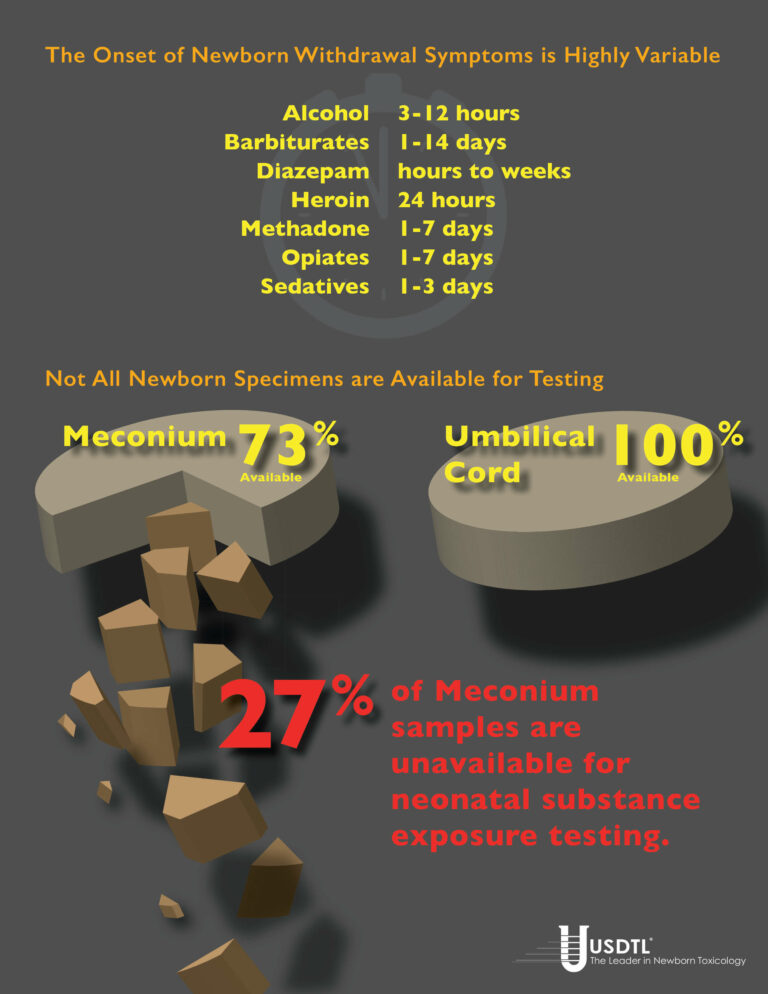Lost Opportunities
Showing: NAS

Numerous studies have shown that meconium specimens are too often unavailable for substance exposure testing. Universal collection of umbilical cord specimens offers a solution.
By Joseph Salerno
Unable, despite her best efforts to shake her addiction, a woman exposes her unborn child to drugs in the womb. The baby is born, healthy and beautiful with all the promise the future holds. Three days later, the withdrawal symptoms kick in. The baby wails, flush with the pains of withdrawal and inconsolable, unable to sleep, experiencing seizures. The NICU physician wants to know what the baby has been exposed to, but now it’s too late. The meconium has already been passed and discarded, and the umbilical cord is gone, lost opportunities for concrete answers. Now it’s a guessing game.
This isn’t just a “what-if” scenario, unfortunately, but a potential reality in a surprisingly large number of newborn substance exposure cases. Withdrawal symptoms in substance exposed newborns can be delayed up to three, five, even seven days after the baby is born. Cases of in utero barbiturate exposure may not manifest withdrawal signs until 14 days post-delivery. By that time it’s too late to test any of the baby’s specimens for biomarkers of substance exposure, because the specimens are gone.
Universal collection of umbilical cord specimens offers a solution to avoid this dilemma. Umbilical cord is the only universally available specimen for substance exposure testing. Numerous studies have shown meconium is not available for testing in up to 27% of births. Meconium may be passed in utero. In some cases, there is not enough meconium volume to test even when it is able to be collected.
And again, meconium may have been passed by the newborn and discarded well before they begin to exhibit withdrawal symptoms. Unfortunately, this can also be a problem when the signs of in utero substance exposure emerge after the umbilical cord has been discarded. Newborn urine testing is not a viable option in these cases, because urine provides only a 1-3 day window of detection for substance exposure biomarkers, compared to the 20 week look-back of umbilical cord.
Universal collection of umbilical cord specimens for every birth ensures there are no lost opportunities should the need for substance exposure testing arise. Umbilical cord collection is extremely easy, requiring very little additional effort during post delivery procedures. Only six inches of the cord is required for substance testing, taking up very little storage space.
Umbilical cord tissue is a very stable and reliable specimen. Cord tissue is stable up to 1 week at room temperature, and up to 3 weeks when refrigerated, without jeopardizing the testing results. This is ample time for the emergence of newborn withdrawal symptoms, even in the most extreme cases. Enough time to avoid a missed opportunity for real answers. Only one donor and one collector are present during the umbilical cord collection – in contrast to the multiple collections and multiple collectors involved with meconium – greatly improving chain-of-custody integrity. Umbilical cord specimens are ready for transport just minutes after the birth, greatly improving turnaround time for results reporting. Meconium passages can be delayed for days before being sent to the lab.
References
1. Arendt, R., Singer, L., Minnes, S. and Salvator, A. (1999). Accuracy in detecting prenatal drug exposure. Journal of Drug Issues. 29(2), 203-214.
2. Ostrea, E., Knapp, D., Tannenbaum, L., Ostrea, A., Romero, A., Salari, V. and Ager, J. (2001). Estimates of illicit drug use during pregnancy by maternal interview, hair analysis, and meconium analysis. Pediatrics. 138, 344-348.
3. Lester, B., ElSohly, M., Wright, L., Smeriglio, V., Verter, J., Bauer, C., Shankaran, S., Bada, H., Walls, C., Huestis, M., Finnegan, L. and Maza, P. (2001). The maternal lifestyle study: Drug use by meconium toxicology and maternal self-report. Pediatrics. 107(2), 309-317.
4. Derauf, C., Katz, A. and Easa, D.. (2003). Agreement between Maternal Self-reported Ethanol Intake and Tobacco Use During Pregnancy and Meconium Assays for Fatty Acid Ethyl Esters and Cotinine. American Journal of Epidemiology. 158, 705–709.
5. Eylera, F., Behnkea, M., Wobiea, K., Garvanb, C. and Tebb, I. (2005). Relative ability of biologic specimens and interviews to detect prenatal cocaine use. Neurotoxicology and Teratology. 27, 677 – 687.
Video links from “The Doctors” re: Newborns Exposed to Drugs And Alcohol in The Womb.
 Methamphetamine Babies
Methamphetamine Babies
Registered nurse Linda West and fellow Angels in Waiting nurses join The Doctorsto share their experiences fostering abandoned methamphetamine babies. OB/GYN Dr. Lisa Masterson explains how using methamphetamine while pregnant affects a growing fetus.
Angels In Waiting
More than 550,000 babies are born every year after exposure to drugs and alcohol in the womb. These babies are often born premature and with serious health issues, which make them “unpopular” for adoption. Registered nurse Linda West took matters into her own hands and founded the organization Angels in Waiting, a network of neonatal intensive care unit nurses who become foster parents for abandoned babies
How We Can Help
USDTL CordStat® definitively confirms opioid exposure. Many NAS babies are poly-substance exposed in utero. CordStat 12 and 13 drug panels identify the majority of opioids along with many drugs often associated with NAS. Positive results are an objective measure and often times the only flag that baby’s home life may need extra care. Go to www.USDTL.com to learn more.
 Q: Is there a test that can differentiate between fetal exposure to heroin and fetal exposure to morphine during the birthing process?
Q: Is there a test that can differentiate between fetal exposure to heroin and fetal exposure to morphine during the birthing process?
A: Yes. The umbilical cord tissue or meconium from a baby whose mother was administered morphine during delivery will only be positive for morphine. The umbilical cord of a baby that is positive for Meconin and/or Monoacetylemorphine (6-MAM) in addition to morphine is indicative of heroin exposure.
Knowing the difference can help doctors and nurses provide a better outcome for baby’s treatment plan.
USDTL now offers a sensitive test for Meconin which is helpful in determining exposure to heroin. Visit www.USDTL.com – testing services for information on umbilical cord testing or contact client services at 800-235-2367.
 Following are links to recent neonatal news reports:
Following are links to recent neonatal news reports:
· WSAZ Huntington, W. Va.
Hospitals and treatment centers are overwhelmed as the medical, social and legal challenges regarding addicted moms and newborns spark problems and progress: http://www.wsaz.com/news/headlines/WSAZ_INVESTIGATES_Drug_Addicted_Pregnant_Women_Reach_Crisis_Stage_133996608.html
· USA Today reports in florida, the number of babies with withdrawl syndrome is up 26% from 2006. http://yourlife.usatoday.com/
· Babies born at a very low birth weight are more likely to have memory and attention problems when they become adults than babies born at a low to normal weight, according to a study published in the December 6, 2011, print issue of Neurology®, the medical journal of the American Academy of Neurology http://www.newswise.com/
gy • Maternal exposure to oxycodone during breastfeeding was associated with a 20.1% rate of infant CNS depression…http://www.jpeds.com/article/S0022-3476(11)00678-0/abstract?elsca1=etoc&elsca2=email&elsca3=0022-3476_201201_160_1&elsca4=pediatrics
 Drug and alcohol abuse occurs in all segments of society. A recent survey from the Substance Abuse and Mental Health Services Administration reported that among pregnant women, aged 15 to 44 years 4.4% used illicit drugs in the previous month, 10.8% reported alcohol use, and 4.7% admitted binge or heavy drinking. Substance abuse is a contributing factor to a variety of developmental and behavioral conditions. A substance abusing mother is more likely to neglect her newborn.
Drug and alcohol abuse occurs in all segments of society. A recent survey from the Substance Abuse and Mental Health Services Administration reported that among pregnant women, aged 15 to 44 years 4.4% used illicit drugs in the previous month, 10.8% reported alcohol use, and 4.7% admitted binge or heavy drinking. Substance abuse is a contributing factor to a variety of developmental and behavioral conditions. A substance abusing mother is more likely to neglect her newborn.
Pregnancy may be the one time in a woman’s life when she would be open to treating important issues like drug and alcohol abuse. Addiction is a serious disease that can improve with treatment. Current identification methods rely on maternal self-report, use of a universal screening tool, or positive urine toxicology results. Maternal self-report may be limited by concerns about social stigma or possible legal implications. Screening tools require skill and training to develop effective interview techniques. Urine toxicology is not an effective tool in identifying alcohol abuse and has limited value with drugs. With the exception of marijuana, urine generally provides a 1-3 day window of exposure for illicit drug use. Therefore; the most effective antenatal drug or alcohol treatment program includes objective drug testing to monitor relapse.
Drug and alcohol toxicology test methods are a key component of any treatment program. USDTL offers customizable drug test panels in a variety of sample matrices, hair, nails, blood, urine, oral fluid, meconium, and umbilical cord sections. The laboratory provides a confirmed test result for a specific drug or metabolite. The unique test panels help identify a growing problem of polysubstance abuse.
Visit our website at https://www.usdtl.com/ for more information.
- Umbilical Cord Tissue Testing for SSRIs
- A Comparison of Turnaround-Times for Two Popular Specimen Types Used for Newborn Toxicology: Meconium and Umbilical Cord Tissue
- Using Umbilical Cord Tissue to Identify Prenatal Ethanol Exposure and Co-exposure to Other Commonly Misused Substances
- Toxicology as a Diagnostic Tool to Identify the Misuse of Drugs in the Perinatal Period
- Specimen Delay
- Drug Classes and Neurotransmitters: Amphetamine, Cocaine, and Hallucinogens
- Environmental Exposure Testing for Delta-8 THC, Delta-9 THC, Delta-10 THC, and CBD
- Bromazolam and Synthetic Benzodiazepines
- October 2024 (5)
- March 2024 (1)
- February 2024 (1)
- January 2024 (3)
- December 2023 (1)
- November 2023 (1)


